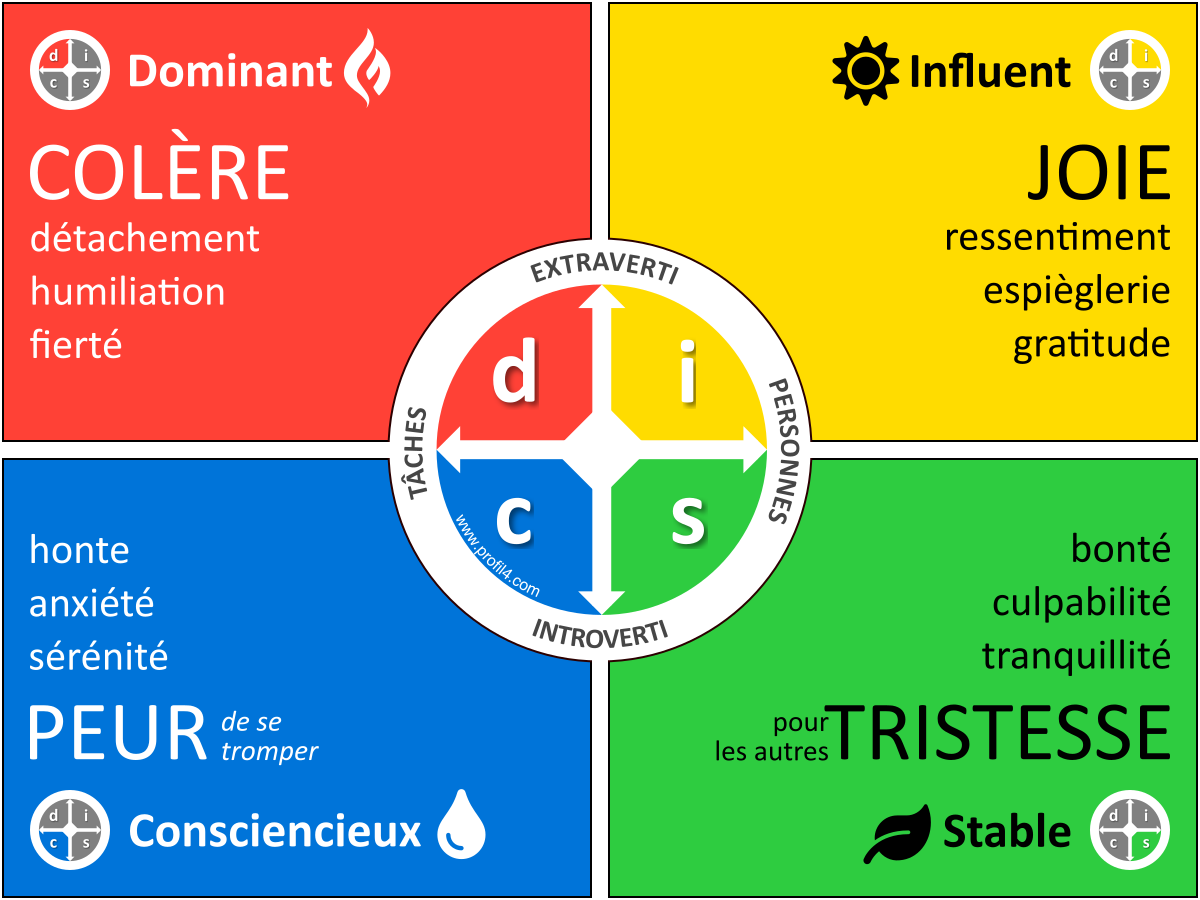Présentation du modèle DISC
The DISC color wheel
Origins of the DISC
The red profile: dominant
The yellow profile: influent
The green profile: stable
The blue profile: Conscientious
8 trends
Communication and Behavior
Motivations - ODAPHIS index
Conflict management
Stress management
Managing mistakes
Improving your sales pitch
Management
At work
Chronoplanning
Vidéos et podcasts
Further research
The DISC color wheel
Origins of the DISC
The red profile: dominant
The yellow profile: influent
The green profile: stable
The blue profile: Conscientious
8 trends
Communication and Behavior
Motivations - ODAPHIS index
Conflict management
Stress management
Managing mistakes
Improving your sales pitch
Management
At work
Chronoplanning
Vidéos et podcasts
Further research
Behavior
Decisive and action-oriented, likes to take the lead.
Can be impatient or demanding of others.
Inclined to take risks and meet challenges.
Highly autonomous, prefers to work independently.
May have difficulty with repetitive tasks or minute details.
Sociable and energetic, likes to be around people.
Can be distracted or lack focus when completing tasks.
Optimistic and motivated by recognition and praise.
Flexible and adaptable, but may lack follow-through.
Seeks to inspire and motivate others.
Reliable and constant, prefers routine and predictability.
May have difficulty with change or uncertainty.
Inclined to avoid risk-taking, preferring security.
Very cooperative and works well in teams.
May sacrifice themself for the well-being of others.
Methodical and organized, follows procedures and rules.
May shy away from improvisation or spontaneity.
Focused on quality and efficiency.
Independent, may prefer to work alone.
May have difficulty with authority if it seems illogical.
Fears
Fear of losing control or being ineffective/impotent.
Fear of being seen as vulnerable or weak.
Fear of being manipulated or exploited.
Worry they might not be respected or someone may challenge their authority.
Apprehension of not achieving objectives and of failure.
Fear of rejection or not being appreciated.
Fear of isolation or not being socially involved.
Worry they might get bored or lack stimulation.
Fear of not being heard or of lacking influence.
Apprehension of losing status or popularity.
Peur du changement soudain ou de l'instabilité.
Crainte de conflits ou de perturbations dans les relations.
Inquiétude face à la perte de sécurité ou de soutien.
Peur de l'imprévisibilité ou des situations inconnues.
Appréhension de ne pas être apprécié ou valorisé dans un groupe.
Fear of error or inaccuracy.
Fear of criticism or judgment of work.
Worry about unpredictability or lack of structure.
Fear of making decisions without sufficient information.
Apprehension of chaos or disorder.
Communication
Direct and concise, straight to the point.
Prefers solution and result-oriented discussions.
Can appear authoritative or assertive in conversations.
Uses clear, unambiguous language to express ideas.
Can be competitive, seeking to have the final say.
Warm and friendly, likes to involve others in a positive way.
Prefers open, expressive conversations, often humorous.
Can sometimes lack structure in the way they communicate.
Inclined to avoid conflict, seeking instead to please.
Uses stories and anecdotes to illustrate their points.
Listens attentively and empathizes, seeking to understand others.
Prefers respectful exchanges and gentle approaches.
May be reluctant to express disagreement or criticism.
Values clarity and coherence in messages.
Seeks to maintain harmony and avoid tension.
Precise and detail-oriented, likes specific information.
May appear critical or finicky in feedback.
Prefers written communication for its clarity.
May be perceived as aloof or reserved in social interactions.
Values logic and facts in arguments.
How to communicate better
Speaking to each profile
Be clear, concise and direct in your communication.
Present the facts and expected results straightforwardly.
Show respect for their time by getting straight to the point.
Offer options and solutions rather than just exposing problems.
Recognize their leadership and effectiveness.
Use a friendly, open tone, encouraging dialogue.
Share stories or examples to illustrate your points.
Show enthusiasm and optimism in your interactions.
Value their creativity and initiative.
Encourage them to express their ideas and feelings.
Practice active listening and empathy.
Communicate calmly and reassuringly, building trust.
Value their contribution and acknowledge their need for stability.
Be patient and give them time to adapt to change.
Use clear instructions and well-defined expectations.
Offer precise details and facts to back up what you say.
Respect their need for analysis and quality in their work.
Communicate in a structured and logical way.
Value their expertise and attention to detail.
Be patient and allow them to ask questions for clarification.

Credits: Outils du Manager
What to avoid
Avoid beating around the bush or being vague.
Don't try to control or limit them with too many unnecessary details.
Avoid non-constructive criticism that doesn't put forward any solutions.
Don't adopt a passive or indecisive attitude.
Avoid criticizing them openly without offering positive support.
Don't ignore their need for recognition and social interaction.
Don't overwhelm them with too many details or constraints.
Avoid restricting their expression or creativity.
Avoid sudden changes or unprepared surprises.
Don't minimize their concerns or resistance to change.
Avoid excessive pressure or impatience.
Don't ignore their need for security and predictability.
Avoid ambiguity and lack of structure in your communication.
Don't make hasty decisions without a logical basis.
Avoid pressing them for an immediate response without giving them time to analyse the situation.
Don't ignore their need for precision and clarity.
Delivering news
Delivering news, good or bad, is a key communication skill. It's important to share good news to strengthen bonds, while bad news requires tact and empathy. In both cases, it's essential to be clear and honest, while also remaining attentive to the listener's reaction and ready to provide the necessary support.
Good news
Emphasize the benefits and positive results.
Show how this strengthens their position or contributes to their objectives.
Share it enthusiastically and energetically.
Highlight the social aspects and opportunities for the team or organization.
Communicate in a calm, reassuring way.
Explain how this news will contribute to stability and general well-being.
Present the information clearly and in detail.
Show how it affects existing processes or standards.
Bad news
Get straight to the point.
Present the facts clearly and put forward solutions or immediate actions to manage the situation.
Approach the situation with empathy and a positive tone.
Point out the positive aspects or lessons to be learned, while maintaining a spirit of optimism.
Be gentle and understanding.
Provide support and continuity, and explain how you will manage any changes so that they have minimum impact.
Be precise and factual.
Provide details and data to explain the situation, and discuss logical solutions.
Podcast
Credits: Outils du Manager
Credits: Outils du Manager
Credits: Outils du Manager
Credits: Outils du Manager





